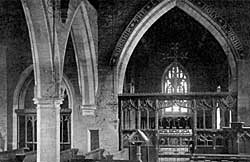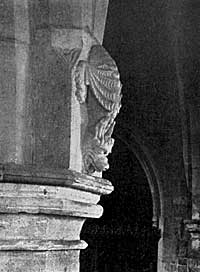
Nuthall Church (interior).
We are thus enabled to trace the gradual development of this interesting little church. First a primitive building erected in pre-conquest days. This had to make way about the time of King John for a larger edifice, which stood for nearly 200 years. Then during the reign of Richard II, when attention had been diverted from the great monastic establishments to the parish churches, the lord of the manor, who had been honoured by a call to parliament as knight of the shire, began to rebuild the nave and aisle in the prevailing style of architecture, providing a tomb therein for himself, but leaving the old tower standing. Before the building was complete, however, Richard had been deposed and a new king, Henry of Bolingbroke, had been elected to the throne. In accordance with a custom then much in vogue, a representation of the heads of the reigning monarchs was carved upon the chief entrance. If this surmise is correct it fixes the date of the erection of the nave and aisle early in the reign of Henry IV., circa 1400. The chancel belongs to the Perpendicular period, and was apparently begun soon after the nave was completed.
The Cokefields succeeded the St. Patricks and held the manor for 200 years. Documents show that they were possessors in 1206. It then passed by marriage through the Thaylboys to the Ayscoughs, an ancient family, connected by marriage with the Strelleys, who presented from 1469 to 1612.
Anne Ayscough, who suffered martyrdom at Smithfield in 1546, was born in the parish of Nuthall, and was daughter of Sir William Ayscough who was knighted at Terouane in 1513.

Carved pillar, Nuthall Church.
There are two ancient piscinae—one in the south wall of the nave, near to the modern pulpit, and one in the chancel, very low down and quite near to the floor. The unusual position of this piscina was brought about in 1884, when the floor of the chancel was raised to its present level.
A monumental slab of red sandstone in the floor of the aisle evidently covers the tomb of a former rector, for on it there is roughly incised a two-stepped cross, together with representations of a book and a chalice. In the floor of the nave, beneath the lectern, is an ancient alabaster slab bearing the following inscription:—
“Here lyes Edward Boun, Gent and Isabell, his wife, daughter and heire of Edmund Hunt, Gent, which Edward died the 12th day of December, in the yere 1558, and the saide Isabell the 13th July in the yere 1562, on whose soules God have mercy. Amen.”
Incised on the slab are the figures of a man and his wife with five children at the foot in half proportion.
The ancient family of Boun were settled at Bakewell by the year 1444. Isabell Boun was one of three sisters, who were heiresses of their father’s manor of Hockerton, in this county. Edward Boun was grandfather to Gilbert Boun, sergeant-at-law. Gilbert was father-in-law to Dr. Robert Thoroton, the local historian, from whom our society takes its name.
At the north-east corner of the chancel, and again at the north-west buttress of the aisle, fragments of incised monumental crosses of great antiquity have been built into the outer walls.
Small and simple as this church is, it nevertheless presents three features that call forth much diversity of opinion.
1.—It will be noticed that the chancel is not in alignment with the nave, but inclines slightly to the north. Three reasons are variously assigned for this:—
(A) That it was purely accidental. It is true that in many of our old churches the chancel is of more recent date than the nave, and any irregularity may be accounted for by the fact that the new chancel was built outside and around the old one before it was pulled down.
(B) That it was done to make the axis point to the spot where the sun rises above the horizon on the dawn of the day of Dedication. When the axis of the whole church diverges slightly from the cardinal point, either to the north or south, this may may have been the cause, but when, as in this case—
(c) The axis of the chancel diverges from the axis of the nave, it is a different matter. So far as I have been able to ascertain the divergence is always to the north, never to the south. When we consider that at the time when this church was built everything was made to bear a symbolical meaning, and when we further consider that from the earliest times until now the tradition concerning the crucifixion has been that the Saviour’s head was turned to the right—probably towards the penitent thief—and is always so represented, there seems good reason for thinking that the divergence was meant to symbolize the drooping of the Saviour’s head when upon the cross.
2.—Then it will be noticed that once upon a time there was a doorway in the north wall, now built up, but still clearly visible from within and without. It is obvious that with a door on the south side and another at the west end there is now no actual need for a door on the north side. But in the ancient Rituals the corpse at a funeral was carried into the church by the north door and carried out by the south one. Hence even the smallest churches had both north and south doors in the nave. In olden days, when the north was symbolical of darkness and ignorance, there seems to have existed a superstitious practice of leaving the north door open in order that evil spirits might pass out of the church that way.
3.—The third feature is the Lychnoscope—the “leper window” of tradition — now blocked up and seen only from outside, the real purpose for which seems doomed to remain wrapped in mystery.
A list of patrons and rectors from A.D,, 1275, may be seen on the wall, near the entrance. The registers date from 1657. The silver chalice and paten was presented in 1662 by Richard Slater, Patron of Nuthall and M.P. for Nottingham in 1678, 1690, 1695, and 1698.
The warm colour of the walling stone used in this church and other ancient buildings in the neighbourhood will attract the attention of strangers. It is quarried in the neighbourhood, and in several places it will be noticed cropping up above the roadways. The Permian bed, that yields such fine building stones in the north of the county, “thins out” south of Mansfield and finally disappears along a line running east and west between Wollaton and Bilborough. At Bulwell a coarse granular variety is quarried, of a light brown colour. As this stone is able to resist the damp it has been, and still is, extensively used for walling as well as for lime burning. At the extremities of the area the stone is of a warmer color, very silicious and contains only a small percentage of lime—it might well be mistaken for a sandstone. It becomes flaggy and interstratified with veins or thin bands of marl, and as these quickly deteriorate on exposure to the weather, the surface soon assumes the worn and lined appearance so noticeable in some of the buildings to be visited, especially the church at Strelley.
